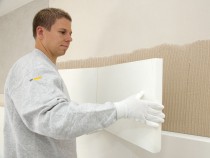
© Sto AG
In recent years, internal insulation has gained in importance. This applies to both historically listed buildings and to buildings that are only partially or temporarily used, such as function rooms or churches. This article presents the current thermal and hygric requirements and gives an overview of advantages and risks, as well as applicable materials and systems.In Germany, DIN 4108 determines the minimum hygienic thermal insulation for external building elements of residential and office buildings. A building element is deemed to comply when its R-value is at least 1,2 W/(m²K), or if its fRsi-factor is at least 0,7. In this case it can be assured that with a room temperature of 20 °C and 50?% relative humidity, the conditions of the inner wall surface and those in corner junctions and around cold bridges will not drop below 12,6 °C and the relative humidity will not exceed 80?%. There is a risk that mildew will form with higher humidity levels on the wall surface. (Daniel Zirkelbach, Hartwig Künzel)


